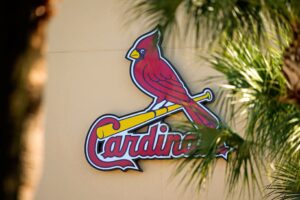What Happened When: 2017 Postseason Anniversaries Part 2/3 covers 1932 to 1977. The three-part series takes a look at October baseball happenings in seasons that ended in 7s and 2s. Part 1 can be found here.
What Happened When: 2017 Postseason Anniversaries Part 2/3
1932
In 1932, the New York Yankees faced, and swept, the Chicago Cubs in the World Series. However, the series is primarily known for the events during the fifth inning of the third game at Wrigley Field. The home run blast that would be known as Babe Ruth’s so-called “Called Shot.” In more recent times evidence has turned up to lend credence to Ruth gesturing towards the taunting Cub dugout as opposed to pointing towards where his home run would eventually wind up. While the mythology has been pretty much debunked, it is still The Bambino doing what he did best to shut up a bunch of trolls.
1937
October of 1937 would see yet another Yankee-Giant version of the Subway Series (fifth of their eventual six as market sharers). This would be a rematch of the 1936 World Series, and the Yankees would prevail 4-1. At this time they were amid their four-in-a-row (1936-1939) string of championships under manager Joe McCarthy.
1942
The era of baseball and World War II tends to begin with the 1942 season. While enough big names were still playing, rosters were starting to get depleted. Still, the Yankees were in the midst of enjoying a run at the top of the American League (sixth time in seven years).
Their opponents would be the St. Louis Cardinals, making their first World Series appearance since the Gas House Gang’s World Championship in 1934. This would be the second time the two franchises would meet. The previous time was in 1926, and like that time the Red Birds would be victorious. In fact, since the 1923 Series, and continuing on through 1953, 1926 and 1942 would be the only time the Yankees would lose the World Series.
1947
The Yankees and Brooklyn Dodgers may have had a World Series between them in 1941, but 1947 is considered the start of the Golden Age of New York City baseball. It was a classic seven-game series, with the Yankees prevailing.
While some pieces that would make up the two teams in their clashes over the next decade were there, including: Jackie Robinson in his color-barrier breaking debut season, Pee Wee Reese, Carl Furillo, Yogi Berra, Allie Reynolds, Phil Rizzuto, and Vic Raschi, this tilt still seems out of place. Most likely due to some remnants of the 1930s-1940s Yankees like Tommy Henrich, Joe DiMaggio, and Spud Chandler still on the team, but it is still as good of a dawn of a new era as you are going to get in baseball history.
1952
Now deep into the “Boys of Summer” era, and coming off two heart-wrenching regular season ending losses (last game of the season to the Whiz Kid Phillies in 1950 and The Shot Heard ‘Round The World to win the three-game playoff series against the Giants the following season), the Dodgers returned to the World Series for the first time since 1949. This time again facing the Yankees.
Oddly enough, like 1947 it would take the Yankees seven games to vanquish the Dodgers (they would need six the following year). The championship would be their fourth of five-in-a-row under manager Casey Stengel, which is still the record for most consecutive MLB World Championships.
1957
If October of 1947 can be seen as the dawn of one chapter of baseball history, the same can be said about October of 1957 and the dawn of the expansion era. As the California-bound Dodgers and Giants were preparing to leave New York City for Los Angeles and San Francisco respectively, a pioneer of the Upper Midwest, the Milwaukee Braves, were ruling the roost in the National League.
Having left Boston following the 1952 season, the Braves were a success in Wisconsin, and in 1957 they reached the pinnacle with the first of back-to-back NL crowns (they faced the Dodgers in an NL playoff series in 1959 as well). Led by Hank Aaron, Lew Burdette, Eddie Mathews, and a holdover from the previous Boston title winner in 1948, Warren Spahn, the Braves beat the Yankees (making their ninth trip to the World Series in 10 years) in seven games. The Yankees would return the favor though the following year, also in seven games.
1962
1962 saw a redux of the 1951 NL Playoff Series, though this time in California, and not as iconic. It would see the same overall result though, with the San Francisco Giants prevailing two games to one. It also is the final series of its kind, as with the introduction of divisional play, such NL tie-breaking games follow what was the AL’s single game format (1948 saw the Cleveland Indians defeating the Boston Red Sox in the AL’s only league playoff tie-breaking deciding game).
The first of which for the NL would be the 1980 one for the NL West, which saw the Houston Astros defeat the Los Angeles Dodgers. Also like the 1951 season, the Giants squared off against the Yankees, and again the Giants would lose to the Yankees in seven games. This would also be the last Yankee championship for 14 years. The Yankees would go on to win the AL pennant in 1963 and 1964, but not again until 1976. A lot would change in those ensuing years for the Bronx Bombers, and the game itself.
1967
The flashpoint for the modern day Red Sox Nation is right here with The Impossible Dream season. Though the Sox would lose to the Cardinals in seven games, the season long exploits of Triple Crown winner Carl Yastrzemski, Cy Young Award winner Jim Lonborg, and the hot start of the season of Tony Conigliaro led to the unbridled love affair the franchise enjoys with New England to this day. On the Red Bird side of things, series MVP Bob Gibson pretty much gave a preview of what he’d bring to the table in 1968, with three wins and an ERA of 1.00.
1972
In midst of their then record-setting five division titles in a row, the Oakland Athletics rebounded from getting swept out of the ALCS by the Baltimore Orioles by winning a hard fought five-game series over the Detroit Tigers.
On the NL side of things, the Cincinnati Reds rebounded from missing the 1971 postseason by defeating the defending World Champion Pittsburgh Pirates, also in a five-game classic.
The Athletics would prevail in seven games, impressively without the help of Reggie Jackson, who had injured himself in the LCS. They won the franchise’s first championship since the Philadelphia Athletics way back in 1930.
1977
The Yankees returned to the top of the baseball world in 1977. Following a whirlwind of an offseason and a season of infighting and insanity, the Yankees followed up their 1976 AL Championship season by returning, and defeating the Kansas City Royals in another five-game classic rematch in the ALCS.
In the NL, the Dodgers bested the Philadelphia Phillies 3-1 in the NLCS.
The stage was set for a series performance for the ages out of Reggie Jackson. Hitting four home runs in his final four World Series at bats, including three in the series’ sixth and final game. With the final shot being an iconic moon shot that landed in the batter’s eye black in Yankee Stadium’s center field bleachers.
For a fun read about 1977 in New York City, where the turbulent first season in New York for Jackson is chronicled as a big part of the story, check out 2006’s Ladies and Gentlemen, The Bronx Is Burning (quote from Howard Cosell from the series when insurance scam fires were seen beyond the Stadium) by Jonathan Mahler. Also, ESPN produced a TV movie about the Yankee portions of the book a year later which is worth watching.
Click here for part 3/3






